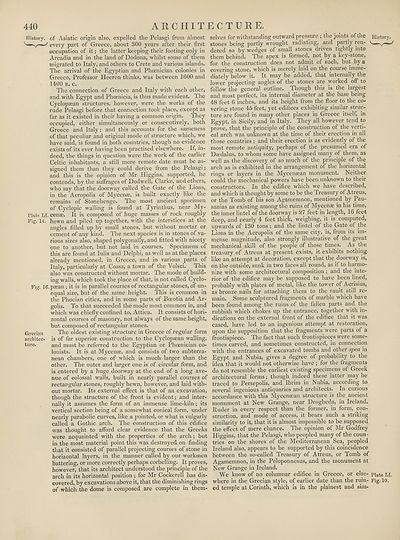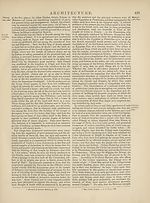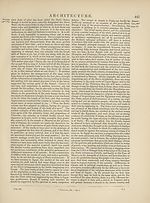Encyclopaedia Britannica > Volume 3, Anatomy-Astronomy
(448) Page 440
Download files
Complete book:
Individual page:
Thumbnail gallery: Grid view | List view

440 ARCHITECTURE.
History, of Asiatic origin also, expelled the Pelasgi from almost
V*-' every part of Greece, about 300 years after their first
occupation of it; the latter keeping their footing only in
Arcadia and in the land of Dodona, whilst some of them
migrated to Italy, and others to Crete and various islands.
The arrival of the Egyptian and Phoenician colonies in
Greece, Professor Heeren thinks, was between 1600 and
1400 b. c.
The connection of Greece and Italy with each other,
and with Egypt and Phoenicia, is thus made evident. The
Cyclopaean structures, however, were the works of the
rude Pelasgi before that connection took place, except as
far as it existed in their having a common origin. They
occupied, either simultaneously or consecutively, both
Greece and Italy; and this accounts for the sameness
of that peculiar and original mode of structure which, we
have said, is found in both countries, though no evidence
exists of its ever having been practised elsewhere. If, in¬
deed, the things in question were the work of the earlier
Celtic inhabitants, a still more remote date must be as¬
signed them than they could derive from the Pelasgi;
and this is the opinion of Mr Higgins, supported, he
contends, by the suffrages of Dodwell, Clarke, and others,
who say that the doorway called the Gate of the Lions,
in the Acropolis of Mycenae, is built exactly like the
remains of Stonehenge. The most ancient specimen
of Cyclopic walling is found at Tyrinthus, near My-
Plate LI. cenae. It is composed of huge masses of rock roughly
Fig. 14. hewn and piled up together, with the interstices at the
angles filled up by small stones, but without mortar or
cement of any kind. The next species is in stones of va¬
rious sizes also, shaped polygonally, and fitted with nicety
one to another, but not laid in courses. Specimens of
this are found at lulis and Delphi, as well as at the places
already mentioned, in Greece, and in various parts of
Italy, particularly at Cossa, a town of the Volsci. This
also was constructed without mortar. The mode of build¬
ing walls, which took the place of that, is not called Cyclo-
Fig. 16. paean ; it is in parallel courses of rectangular stones, of un¬
equal size, but of the same height. This is common in
the Phocian cities, and in some parts of Boeotia and Ar-
golis. To that succeeded the mode most common in, and
which was chiefly confined to, Attica. It consists of hori¬
zontal courses of masonry, not always of the same height,
but composed of rectangular stones.
Grecian The oldest existing structure in Greece of regular form
architec- is of far superior construction to the Cyclopaean walling,
tare. and must be referred to the Egyptian or Phoenician co¬
lonists. It is at Mycenae, and consists of two subterra¬
nean chambers, one of which is much larger than the
other. The outer and larger one is of circular form, and
is entered by a huge doorway at the end of a long ave¬
nue of colossal walls, built in nearly parallel courses of
rectangular stones, roughly hewn, however, and laid with¬
out mortar. Its external effect is that of an excavation,
though the structure of the front is evident; and inter¬
nally it assumes the form of an immense lime-kiln; its
vertical section being of a somewhat conical form, under
nearly parabolic curves, like a pointed, or what is vulgarly
called a Gothic arch. The construction of this edifice
was thought to afford clear evidence that the Greeks
were acquainted with the properties of the arch; but
in the most material point this was destroyed on finding
that it consisted of parallel projecting courses of stone in
horizontal layers, in the manner called by our workmen
battering, or more correctly perhaps corbelling. It proves,
however, that its architect understood the principle of the
arch in its horizontal position ; for Mr Cockerell has dis¬
covered, by excavations above it, that the diminishing rings
of which the dome is composed are complete in them¬
selves for withstanding outward pressure ; the joints of the History,
stones being partly wrought radiating, and partly ren-
dered so by wedges of small stones driven tightly into
them behind. The apex is formed, not by a key-stone,
for the construction does not admit of such, but bj a
covering stone, which is merely laid on the course imme¬
diately below it. It may be added, that internally the
lower projecting angles of the stones are worked off to
follow the general outline. Though this is the largest
and most perfect, its internal diameter at the base being
48 feet 6 inches, and its height from the floor to the co¬
vering stone 45 feet, yet edifices exhibiting similar struc¬
ture are found in many other places in Greece itself, in
Egypt, in Sicily, and in Italy. They all however tend to
prove, that the principle of the construction of the verti¬
cal arch was unknown at the time of their erection in all
those countries ; and their erection is as evidently of the
most remote antiquity, perhaps of the presumed era of
Daedalus, to whom some have assigned many of them, as
well as the discovery of so much of the principle of the
arch as is exhibited in the arrangement of the horizontal
rings or layers in the Mycenaean monument. Neither
could the mechanical powers have been unknown to their
constructors. In the edifice which we have described,
and which is thought by some to be the Treasury of Atreus,
or the Tomb of his son Agamemnon, mentioned by Pau-
sanias as existing among the ruins of Mycenae in his time,
the inner lintel of the doorway is 27 feet in length, 16 feet
deep, and nearly 4 feet thick, weighing, it is computed,
upwards of 130 tons ; and the lintel of the Gate of the
Lions in the Acropolis of the same city, is, from its im¬
mense magnitude, also strongly illustrative of the great
mechanical skill of the people of those times. As the
treasury of Atreus at present exists, it exhibits nothing
like an attempt at decoration, except that the doorway is,
on the outside, sunk in two faces all round, as if to harmo¬
nize with some architectural composition ; and the inte¬
rior of the edifice may be supposed to have been lined,
probably with plates of metal, like the tower of Acrisius,
as bronze nails for attaching them to the vault still re¬
main. Some sculptured fragments of marble which have
been found among the ruins of the fallen parts and the
rubbish which chokes up the entrance, together with in¬
dications on the external front of the edifice that it was
cased, have led to an ingenious attempt at restoration,
upon the supposition that the fragments were parts of a
frontispiece. The fact that such frontispieces were some¬
times carved, and sometimes constructed, in connection
with the entrances of excavated tombs and other spea in
Egypt and Nubia, gives a degree of probability to the
idea that it would not otherwise have ; for the fragments
do not resemble the earliest existing specimens of Greek
architectural forms; though indeed these latter may be
traced to Persepolis, and Ibrim in Nubia, according to
several ingenious antiquaries and architects. In curious
accordance with this Mycenaean structure is the ancient
monument at New Grange, near Drogheda, in Ireland.
Ruder in every respect than the former, in form, con¬
struction, and mode of access, it bears such a striking
similarity to it, that it is almost impossible to be supposed
the effect of mere chance. The opinion of Mr Godfrey
Higgins, that the Pelasgi, who peopled many of the coun¬
tries on the shores of the Mediterranean Sea, peopled
Ireland also, appears to be supported by this coincidence
between the so-called Treasury of Atreus, or Tomb of
Agamemnon, in the Peloponnesus, and the monument at
New Grange in Ireland.
We know of no columnar edifice in Greece, or else- piate Li.
where in the Grecian style, of earlier date than the ruin- Fig. io.
ed temple at Corinth, which is in the plainest and sim-
History, of Asiatic origin also, expelled the Pelasgi from almost
V*-' every part of Greece, about 300 years after their first
occupation of it; the latter keeping their footing only in
Arcadia and in the land of Dodona, whilst some of them
migrated to Italy, and others to Crete and various islands.
The arrival of the Egyptian and Phoenician colonies in
Greece, Professor Heeren thinks, was between 1600 and
1400 b. c.
The connection of Greece and Italy with each other,
and with Egypt and Phoenicia, is thus made evident. The
Cyclopaean structures, however, were the works of the
rude Pelasgi before that connection took place, except as
far as it existed in their having a common origin. They
occupied, either simultaneously or consecutively, both
Greece and Italy; and this accounts for the sameness
of that peculiar and original mode of structure which, we
have said, is found in both countries, though no evidence
exists of its ever having been practised elsewhere. If, in¬
deed, the things in question were the work of the earlier
Celtic inhabitants, a still more remote date must be as¬
signed them than they could derive from the Pelasgi;
and this is the opinion of Mr Higgins, supported, he
contends, by the suffrages of Dodwell, Clarke, and others,
who say that the doorway called the Gate of the Lions,
in the Acropolis of Mycenae, is built exactly like the
remains of Stonehenge. The most ancient specimen
of Cyclopic walling is found at Tyrinthus, near My-
Plate LI. cenae. It is composed of huge masses of rock roughly
Fig. 14. hewn and piled up together, with the interstices at the
angles filled up by small stones, but without mortar or
cement of any kind. The next species is in stones of va¬
rious sizes also, shaped polygonally, and fitted with nicety
one to another, but not laid in courses. Specimens of
this are found at lulis and Delphi, as well as at the places
already mentioned, in Greece, and in various parts of
Italy, particularly at Cossa, a town of the Volsci. This
also was constructed without mortar. The mode of build¬
ing walls, which took the place of that, is not called Cyclo-
Fig. 16. paean ; it is in parallel courses of rectangular stones, of un¬
equal size, but of the same height. This is common in
the Phocian cities, and in some parts of Boeotia and Ar-
golis. To that succeeded the mode most common in, and
which was chiefly confined to, Attica. It consists of hori¬
zontal courses of masonry, not always of the same height,
but composed of rectangular stones.
Grecian The oldest existing structure in Greece of regular form
architec- is of far superior construction to the Cyclopaean walling,
tare. and must be referred to the Egyptian or Phoenician co¬
lonists. It is at Mycenae, and consists of two subterra¬
nean chambers, one of which is much larger than the
other. The outer and larger one is of circular form, and
is entered by a huge doorway at the end of a long ave¬
nue of colossal walls, built in nearly parallel courses of
rectangular stones, roughly hewn, however, and laid with¬
out mortar. Its external effect is that of an excavation,
though the structure of the front is evident; and inter¬
nally it assumes the form of an immense lime-kiln; its
vertical section being of a somewhat conical form, under
nearly parabolic curves, like a pointed, or what is vulgarly
called a Gothic arch. The construction of this edifice
was thought to afford clear evidence that the Greeks
were acquainted with the properties of the arch; but
in the most material point this was destroyed on finding
that it consisted of parallel projecting courses of stone in
horizontal layers, in the manner called by our workmen
battering, or more correctly perhaps corbelling. It proves,
however, that its architect understood the principle of the
arch in its horizontal position ; for Mr Cockerell has dis¬
covered, by excavations above it, that the diminishing rings
of which the dome is composed are complete in them¬
selves for withstanding outward pressure ; the joints of the History,
stones being partly wrought radiating, and partly ren-
dered so by wedges of small stones driven tightly into
them behind. The apex is formed, not by a key-stone,
for the construction does not admit of such, but bj a
covering stone, which is merely laid on the course imme¬
diately below it. It may be added, that internally the
lower projecting angles of the stones are worked off to
follow the general outline. Though this is the largest
and most perfect, its internal diameter at the base being
48 feet 6 inches, and its height from the floor to the co¬
vering stone 45 feet, yet edifices exhibiting similar struc¬
ture are found in many other places in Greece itself, in
Egypt, in Sicily, and in Italy. They all however tend to
prove, that the principle of the construction of the verti¬
cal arch was unknown at the time of their erection in all
those countries ; and their erection is as evidently of the
most remote antiquity, perhaps of the presumed era of
Daedalus, to whom some have assigned many of them, as
well as the discovery of so much of the principle of the
arch as is exhibited in the arrangement of the horizontal
rings or layers in the Mycenaean monument. Neither
could the mechanical powers have been unknown to their
constructors. In the edifice which we have described,
and which is thought by some to be the Treasury of Atreus,
or the Tomb of his son Agamemnon, mentioned by Pau-
sanias as existing among the ruins of Mycenae in his time,
the inner lintel of the doorway is 27 feet in length, 16 feet
deep, and nearly 4 feet thick, weighing, it is computed,
upwards of 130 tons ; and the lintel of the Gate of the
Lions in the Acropolis of the same city, is, from its im¬
mense magnitude, also strongly illustrative of the great
mechanical skill of the people of those times. As the
treasury of Atreus at present exists, it exhibits nothing
like an attempt at decoration, except that the doorway is,
on the outside, sunk in two faces all round, as if to harmo¬
nize with some architectural composition ; and the inte¬
rior of the edifice may be supposed to have been lined,
probably with plates of metal, like the tower of Acrisius,
as bronze nails for attaching them to the vault still re¬
main. Some sculptured fragments of marble which have
been found among the ruins of the fallen parts and the
rubbish which chokes up the entrance, together with in¬
dications on the external front of the edifice that it was
cased, have led to an ingenious attempt at restoration,
upon the supposition that the fragments were parts of a
frontispiece. The fact that such frontispieces were some¬
times carved, and sometimes constructed, in connection
with the entrances of excavated tombs and other spea in
Egypt and Nubia, gives a degree of probability to the
idea that it would not otherwise have ; for the fragments
do not resemble the earliest existing specimens of Greek
architectural forms; though indeed these latter may be
traced to Persepolis, and Ibrim in Nubia, according to
several ingenious antiquaries and architects. In curious
accordance with this Mycenaean structure is the ancient
monument at New Grange, near Drogheda, in Ireland.
Ruder in every respect than the former, in form, con¬
struction, and mode of access, it bears such a striking
similarity to it, that it is almost impossible to be supposed
the effect of mere chance. The opinion of Mr Godfrey
Higgins, that the Pelasgi, who peopled many of the coun¬
tries on the shores of the Mediterranean Sea, peopled
Ireland also, appears to be supported by this coincidence
between the so-called Treasury of Atreus, or Tomb of
Agamemnon, in the Peloponnesus, and the monument at
New Grange in Ireland.
We know of no columnar edifice in Greece, or else- piate Li.
where in the Grecian style, of earlier date than the ruin- Fig. io.
ed temple at Corinth, which is in the plainest and sim-
Set display mode to:
![]() Universal Viewer |
Universal Viewer | ![]() Mirador |
Large image | Transcription
Mirador |
Large image | Transcription
Images and transcriptions on this page, including medium image downloads, may be used under the Creative Commons Attribution 4.0 International Licence unless otherwise stated. ![]()
| Encyclopaedia Britannica > Encyclopaedia Britannica > Volume 3, Anatomy-Astronomy > (448) Page 440 |
|---|
| Permanent URL | https://digital.nls.uk/193763172 |
|---|
| Attribution and copyright: |
|
|---|---|
| Shelfmark | EB.16 |
|---|---|
| Description | Ten editions of 'Encyclopaedia Britannica', issued from 1768-1903, in 231 volumes. Originally issued in 100 weekly parts (3 volumes) between 1768 and 1771 by publishers: Colin Macfarquhar and Andrew Bell (Edinburgh); editor: William Smellie: engraver: Andrew Bell. Expanded editions in the 19th century featured more volumes and contributions from leading experts in their fields. Managed and published in Edinburgh up to the 9th edition (25 volumes, from 1875-1889); the 10th edition (1902-1903) re-issued the 9th edition, with 11 supplementary volumes. |
|---|---|
| Additional NLS resources: |
|

